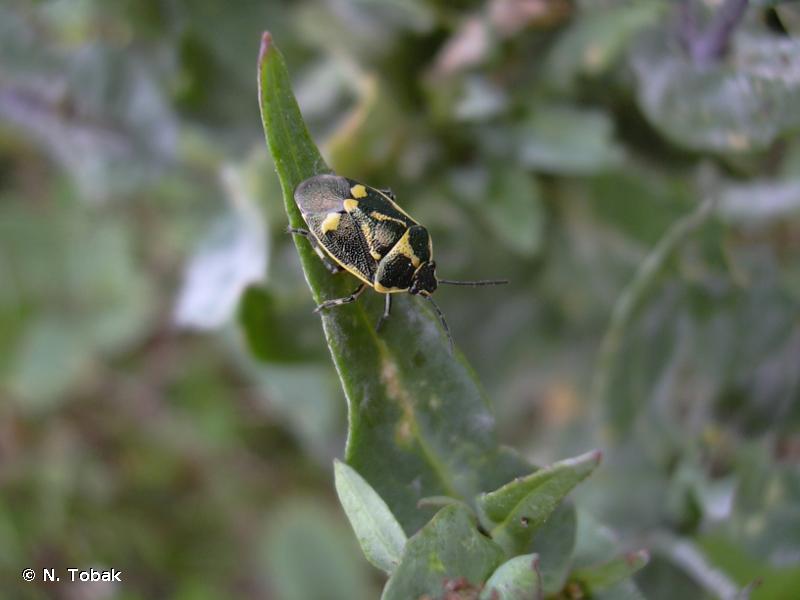
cd_nom

| Author : C. Quintin |
 |
To get the picture, please visit:
Christophe Quintin
email : inpn@mnhn.fr
Despite the Creative Commons license, please inform the author of the use which will be made of his photo

| Author : J. Touroult |
 |
To get the picture, please visit:
Despite the Creative Commons license, please inform the author of the use which will be made of his photo

| Author : N. Tobak |
 |
To get the picture, please visit:
Nicolas Tobak
email : nico.tobak@gmail.com
Despite the Creative Commons license, please inform the author of the use which will be made of his photo

| Author : R. Baghi |
 |
Despite the Creative Commons license, please inform the author of the use which will be made of his photo
Taille : 5 – 7,5 mm
Diagnose :
Petite punaise de coloration générale bleu-vert foncé à reflets métalliques, bariolée de taches claires rouges, orange ou blanches. Corie (partie sclérifiée de l'aile antérieure) dont la partie centrale (mésocorie) porte une seule tache claire. Pronotum entouré par un liseré clair, avec une ligne médiane claire formant 2 fenêtres sombres
Détermination : Simple.
Espèces proches :
Malgré des variations importantes de ses couleurs et de la forme de ses taches (30 formes connues), cette espèce globalement verte avec une seule tache sur les mésocories, est l'une des plus faciles à identifier dans le genre Eurydema.
Période d'observation :
Mars à novembre, avec 2 pics importants en mai et août.
Biologie-éthologie :
Elle s'alimente sur les fruits d'une cinquantaine de genres de crucifères. Son régime alimentaire a bien été étudié en raison des dégâts qu'elle peut causer aux cultures de choux. Elle est aussi parfois rencontrée ponctuellement sur des graminées et des Asteracées.
Biogéographie et écologie :
Espèce eurosibérienne présente dans le sud de la Grande-Bretagne, elle remonte au nord jusqu'en Suède à 65° de latitude nord et à l'est jusqu'en Chine et dans toute la Sibérie. Elle est également présente en Afrique du Nord. Elle peut atteindre localement 2 100 m d'altitude et vit dans une large gamme d'habitats : cultures de choux et autres crucifères comestibles (navet, moutarde, colza), friches et prairies fleuries, landes et lisières forestières, bords des chemins, pelouses rases, dunes, marais, bords de rivière boisés, terrains vagues, parcs et jardins. C'est une espèce très commune avec des densités parfois localement importantes, notamment dans les cultures de crucifères.
Roland Lupoli (),2020
Continental
Metropolitan France
Overseas
Marine
Metropolitan France
Overseas
The map presents a summary at the 10 x 10 km grid of the observation data for the species transmitted to the SINP. These data have been subjected to validation filters.
The map presents a reference distribution layer of the species at the scale of departments and marine sectors. The presence and absence data were established by expertise within a network of partners. This reference distribution is used in the validation process of the SINP data at the INPN level.
Corresponds to a report on the basis of at least one observation proved within a period of 10 years (20 years for little-known invertebrates) preceding the year and no presumption of extinction since obtaining the last data nor doubt on reproductive and implemented nature of this population. For migratory species, the presence indicated concerns areas of reproduction.
This status is based on one or more of the following criteria:
This point covers the absence, more difficult by nature to demonstrate than presence. This status is based on one or more of the following criteria:
This status must be assigned to a department in which the presence of the species is casual.
Particular case of absence due to a proven extinction less than a half century ago (older disappearances are treated as "no probable or definite").
In the state of knowledge, we can not comment on the presence or absence in the current department. This is the default status when not comprised in one of the previous categories or whenever there is doubt.
The map shows the global distribution of the species based on GBIF data (Global Biodiversity Information Facility).
